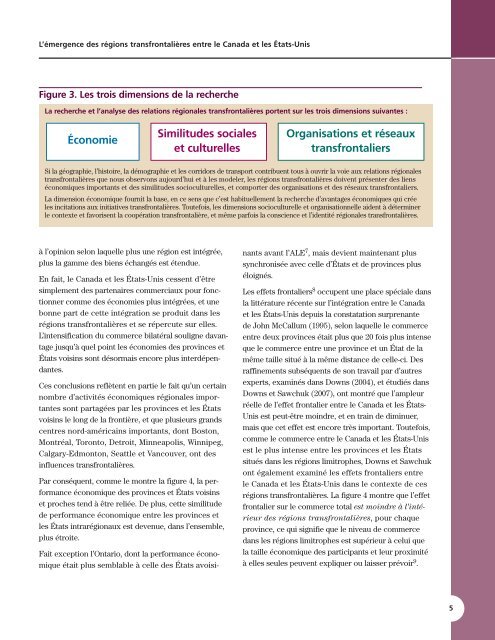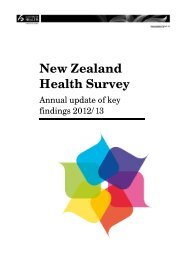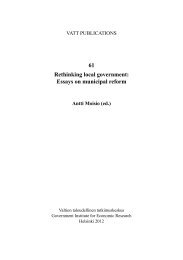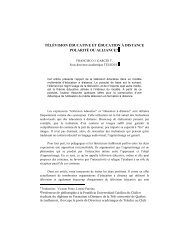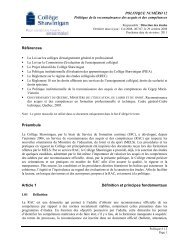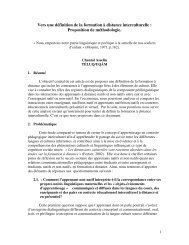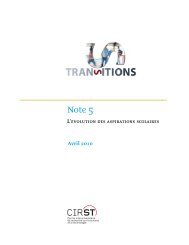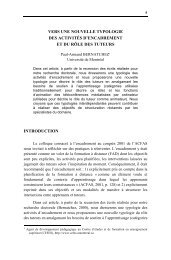L'émergence des régions transfrontalières entre le Canada et les ...
L'émergence des régions transfrontalières entre le Canada et les ...
L'émergence des régions transfrontalières entre le Canada et les ...
You also want an ePaper? Increase the reach of your titles
YUMPU automatically turns print PDFs into web optimized ePapers that Google loves.
L’émergence <strong>des</strong> <strong>régions</strong> <strong>transfrontalières</strong> <strong>entre</strong> <strong>le</strong> <strong>Canada</strong> <strong>et</strong> <strong>le</strong>s États-Unis<br />
Figure 3. Les trois dimensions de la recherche<br />
La recherche <strong>et</strong> l’analyse <strong>des</strong> relations régiona<strong>le</strong>s <strong>transfrontalières</strong> portent sur <strong>le</strong>s trois dimensions suivantes :<br />
Économie<br />
Similitu<strong>des</strong> socia<strong>le</strong>s<br />
<strong>et</strong> culturel<strong>le</strong>s<br />
Organisations <strong>et</strong> réseaux<br />
transfrontaliers<br />
Si la géographie, l’histoire, la démographie <strong>et</strong> <strong>le</strong>s corridors de transport contribuent tous à ouvrir la voie aux relations régiona<strong>le</strong>s<br />
<strong>transfrontalières</strong> que nous observons aujourd’hui <strong>et</strong> à <strong>le</strong>s mode<strong>le</strong>r, <strong>le</strong>s <strong>régions</strong> <strong>transfrontalières</strong> doivent présenter <strong>des</strong> liens<br />
économiques importants <strong>et</strong> <strong>des</strong> similitu<strong>des</strong> socioculturel<strong>le</strong>s, <strong>et</strong> comporter <strong>des</strong> organisations <strong>et</strong> <strong>des</strong> réseaux transfrontaliers.<br />
La dimension économique fournit la base, en ce sens que c’est habituel<strong>le</strong>ment la recherche d’avantages économiques qui crée<br />
<strong>le</strong>s incitations aux initiatives <strong>transfrontalières</strong>. Toutefois, <strong>le</strong>s dimensions socioculturel<strong>le</strong> <strong>et</strong> organisationnel<strong>le</strong> aident à déterminer<br />
<strong>le</strong> contexte <strong>et</strong> favorisent la coopération transfrontalière, <strong>et</strong> même parfois la conscience <strong>et</strong> l’identité régiona<strong>le</strong>s <strong>transfrontalières</strong>.<br />
à l’opinion selon laquel<strong>le</strong> plus une région est intégrée,<br />
plus la gamme <strong>des</strong> biens échangés est étendue.<br />
En fait, <strong>le</strong> <strong>Canada</strong> <strong>et</strong> <strong>le</strong>s États-Unis cessent d’être<br />
simp<strong>le</strong>ment <strong>des</strong> partenaires commerciaux pour fonctionner<br />
comme <strong>des</strong> économies plus intégrées, <strong>et</strong> une<br />
bonne part de c<strong>et</strong>te intégration se produit dans <strong>le</strong>s<br />
<strong>régions</strong> <strong>transfrontalières</strong> <strong>et</strong> se répercute sur el<strong>le</strong>s.<br />
L’intensification du commerce bilatéral souligne davantage<br />
jusqu’à quel point <strong>le</strong>s économies <strong>des</strong> provinces <strong>et</strong><br />
États voisins sont désormais encore plus interdépendantes.<br />
Ces conclusions reflètent en partie <strong>le</strong> fait qu’un certain<br />
nombre d’activités économiques régiona<strong>le</strong>s importantes<br />
sont partagées par <strong>le</strong>s provinces <strong>et</strong> <strong>le</strong>s États<br />
voisins <strong>le</strong> long de la frontière, <strong>et</strong> que plusieurs grands<br />
c<strong>entre</strong>s nord-américains importants, dont Boston,<br />
Montréal, Toronto, D<strong>et</strong>roit, Minneapolis, Winnipeg,<br />
Calgary-Edmonton, Seatt<strong>le</strong> <strong>et</strong> Vancouver, ont <strong>des</strong><br />
influences <strong>transfrontalières</strong>.<br />
Par conséquent, comme <strong>le</strong> montre la figure 4, la performance<br />
économique <strong>des</strong> provinces <strong>et</strong> États voisins<br />
<strong>et</strong> proches tend à être reliée. De plus, c<strong>et</strong>te similitude<br />
de performance économique <strong>entre</strong> <strong>le</strong>s provinces <strong>et</strong><br />
<strong>le</strong>s États intrarégionaux est devenue, dans l’ensemb<strong>le</strong>,<br />
plus étroite.<br />
Fait exception l’Ontario, dont la performance écono -<br />
mique était plus semblab<strong>le</strong> à cel<strong>le</strong> <strong>des</strong> États avoisinants<br />
avant l’ALE 7 , mais devient maintenant plus<br />
synchronisée avec cel<strong>le</strong> d’États <strong>et</strong> de provinces plus<br />
éloignés.<br />
Les eff<strong>et</strong>s frontaliers 8 occupent une place spécia<strong>le</strong> dans<br />
la littérature récente sur l’intégration <strong>entre</strong> <strong>le</strong> <strong>Canada</strong><br />
<strong>et</strong> <strong>le</strong>s États-Unis depuis la constatation surprenante<br />
de John McCallum (1995), selon laquel<strong>le</strong> <strong>le</strong> commerce<br />
<strong>entre</strong> deux provinces était plus que 20 fois plus intense<br />
que <strong>le</strong> commerce <strong>entre</strong> une province <strong>et</strong> un État de la<br />
même tail<strong>le</strong> situé à la même distance de cel<strong>le</strong>-ci. Des<br />
raffinements subséquents de son travail par d’autres<br />
experts, examinés dans Downs (2004), <strong>et</strong> étudiés dans<br />
Downs <strong>et</strong> Sawchuk (2007), ont montré que l’amp<strong>le</strong>ur<br />
réel<strong>le</strong> de l’eff<strong>et</strong> frontalier <strong>entre</strong> <strong>le</strong> <strong>Canada</strong> <strong>et</strong> <strong>le</strong>s États-<br />
Unis est peut-être moindre, <strong>et</strong> en train de diminuer,<br />
mais que c<strong>et</strong> eff<strong>et</strong> est encore très important. Toutefois,<br />
comme <strong>le</strong> commerce <strong>entre</strong> <strong>le</strong> <strong>Canada</strong> <strong>et</strong> <strong>le</strong>s États-Unis<br />
est <strong>le</strong> plus intense <strong>entre</strong> <strong>le</strong>s provinces <strong>et</strong> <strong>le</strong>s États<br />
situés dans <strong>le</strong>s <strong>régions</strong> limitrophes, Downs <strong>et</strong> Sawchuk<br />
ont éga<strong>le</strong>ment examiné <strong>le</strong>s eff<strong>et</strong>s frontaliers <strong>entre</strong><br />
<strong>le</strong> <strong>Canada</strong> <strong>et</strong> <strong>le</strong>s États-Unis dans <strong>le</strong> contexte de ces<br />
<strong>régions</strong> <strong>transfrontalières</strong>. La figure 4 montre que l’eff<strong>et</strong><br />
frontalier sur <strong>le</strong> commerce total est moindre à l’inté -<br />
rieur <strong>des</strong> <strong>régions</strong> <strong>transfrontalières</strong>, pour chaque<br />
province, ce qui signifie que <strong>le</strong> niveau de commerce<br />
dans <strong>le</strong>s <strong>régions</strong> limitrophes est supérieur à celui que<br />
la tail<strong>le</strong> économique <strong>des</strong> participants <strong>et</strong> <strong>le</strong>ur proximité<br />
à el<strong>le</strong>s seu<strong>le</strong>s peuvent expliquer ou laisser prévoir 9 .<br />
5


